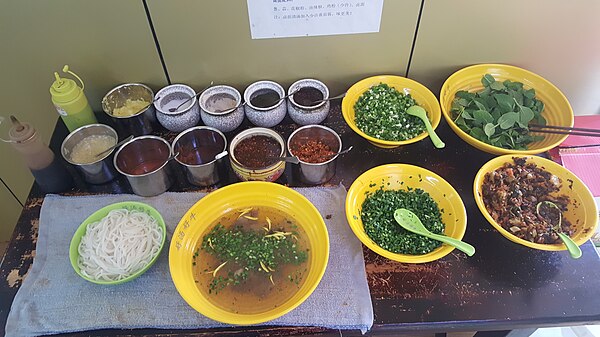Mixian (Rice Noodle) in Yunnan
Mixian (simplified Chinese: 米线; traditional Chinese: 米線; pinyin: mǐxiàn) is a type of rice noodle from the Yunnan Province, China. It is made from ordinary non-glutinous rice, and it is generally sold fresh rather than dried.
Production
The processing of mixian in Yunnan is unique, involving a fermentation process. In many areas there are at least two distinct thicknesses produced, a thinner form (roughly 1.5mm diameter) and a thicker form (roughly 3.5-4mm diameter).
Serving
Mixian is served in various ways, either in broth or stir-fried.
Stir-fried
Stir-fried preparation is rapid, most common in the evening, and is popular at road-side BBQ stands throughout Yunnan. Egg, tomato, meat, spring onion and chilli are frequently utilized.
Broth
The most famous prepared dish is guoqiao mixian (過橋米線/过桥米线; literally “crossing the bridge noodles”).
More normally, when mixian is served in broth in Yunnanese restaurants, it is an extremely popular breakfast and day-time dish. Broths are generally chicken or beef, though others exist.
It is common for a range of individual condiments to be presented for the customer to add to their bowl themselves. Usually the noodles are first added to the broth (see copper pot image on the right), but sometimes the customer is presented the noodles in a separate bowl (see condiment image, below). In this latter case, condiments are generally added directly to the broth prior to adding the noodles.
Meat is generally added to the broth and may be in the form of larger, chunkier pieces (even including bone) or thin-sliced fillets.

A large serving of beef mixian noodles with available condiments, as served in a typical local restaurant in Kunming. The broth includes chrysanthemum flowers.
Condiments vary significantly but may typically include some subset of the following:
- chicken powder or essence
- chili pepper (diced fresh chili, plus at least one or two prepared chilli pastes, often mixed with oil)
- chrysanthemum flowers
- coriander
- mint
- garlic (often finely diced, in liquid suspension, or in thin sectioned slices)
- ginger (as above, but less commonly in slices)
- pepper (both regular pepper and powdered or whole Sichuan pepper)
- salt
- sesame oil
- Sichuan pepper oil
- soy sauce
- spring onion
- suan cai (pickled or preserved vegetable)
- tomato
- vinegar
- wood ear mushroom
- zhe’ergen (a spicy root common to southwestern China).
The creation of a rich, personal broth is a quintessential part of the mixian experience.
Geographical extent
Mixian is popular in Yunnan Province, where it can be found in many streets and villages, and is occasionally available in other mainland Chinese cities. It is generally very difficult to obtain outside of mainland China, probably since the fresh method of preparation could be seen to necessitate a certain minimum volume of consumption in order to be commercially viable. It is relatively similar to noodles consumed in neighbouring Laos (feu) and Vietnam (phở), with the key difference that the base mixian broth is usually heavily personalized by the customer in Yunnanese tradition, and the establishment’s own pre-made broth is less adulterated and more significantly appreciated/judged as a key factor of the in Vietnam (and perhaps to a lesser extent Laos). Dishes like nan gyi thohk and baik kut kyee kaik in various parts of Myanmar are similar dimension rice noodle based but different broadly in flavour profile (tending more toward flavours in Indian cuisine with ingredients such as chickpea flour) and preparatory method (far greater use of frying). It is more common in unadulterated Yunnanese form in commercial centers of Myanmar with growing Chinese populations, such as Mandalay. Dishes in Thailand such as pad thai also rely on rice noodles, though often they are flat and therefore more similar to Chinese juanfen or Yunnanese migan. A Tibetan broth-based noodle dish using wheat-flour instead of rice-flour noodles, thukpa, is thought to have originated in eastern Tibet (i.e. closer to Yunnan) is made and enjoyed throughout Bhutan, northeast India, Nepal, Sikkim, Tibet.

 7 Days GolfingTour
7 Days GolfingTour
 8 Days Group Tour
8 Days Group Tour
 8 Days Yunnan Tour
8 Days Yunnan Tour
 7 Days Shangri La Hiking
7 Days Shangri La Hiking
 11 Days Yunnan Tour
11 Days Yunnan Tour
 6 Days Yuanyang Terraces
6 Days Yuanyang Terraces
 11 Days Yunnan Tour
11 Days Yunnan Tour
 8 Days South Yunnan
8 Days South Yunnan
 7 Days Tea Tour
7 Days Tea Tour
 8 Days Muslim Tour
8 Days Muslim Tour
 12 Days Self-Driving
12 Days Self-Driving
 4 Days Haba Climbing
4 Days Haba Climbing
 Tiger Leaping Gorge
Tiger Leaping Gorge
 Stone Forest
Stone Forest
 Yunnan-Tibet
Yunnan-Tibet
 Hani Rice Terraces
Hani Rice Terraces
 Kunming
Kunming
 Lijiang
Lijiang
 Shangri-la
Shangri-la
 Dali
Dali
 XishuangBanna
XishuangBanna
 Honghe
Honghe
 Kunming
Kunming
 Lijiang
Lijiang
 Shangri-la
Shangri-la
 Yuanyang Rice Terraces
Yuanyang Rice Terraces
 Nujiang
Nujiang
 XishuangBanna
XishuangBanna
 Spring City Golf
Spring City Golf
 Snow Mountain Golf
Snow Mountain Golf
 Stone Mountain Golf
Stone Mountain Golf












